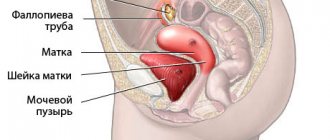Colposcopy is a highly informative method for diagnosing diseases of the cervix, vagina, and vulva, allowing one to determine the condition of the epithelium of the cervix, vagina, and vulva at various physiological periods of a woman’s life, relieving her of the use of invasive diagnostic and treatment methods.
A modern colposcope is a binocular microscope with a built-in light source and a lens located on a holding device. Video colposcopy (digital colposcopy) is carried out using a special device equipped with a camera, the image from which is transmitted to the monitor. The image obtained using a video colposcope can be seen by the patient herself. This helps to get rid of the fear of the disease and realize the need for treatment, as well as make sure there is no pathology.
During extended colposcopy, tissues are treated with special solutions.
What does a cervical colposcopy show?
Colposcopy is prescribed to almost everyone for prevention, as well as in the presence of diseases or suspicions of them. Unfortunately, cervical pathology is a very common problem today, so it is necessary to undergo periodic preventive examinations even in the absence of symptoms.
What does colposcopy reveal:
- cervical erosion;
- dysplasia;
- neoplasms (benign or malignant);
- polyps, cysts;
- papillomas, condylomas.
A colposcope allows you to thoroughly study the structure of tissues and its changes, and can identify precancerous conditions (which will allow you to begin treatment and prevent further development of the disease).
General information
Colposcopy is a modern diagnostic method necessary for the timely detection of cervical pathology. To carry out this procedure, the gynecologist uses a colposcope, a device that can visually enlarge the examined area by 4-40 times. This allows the doctor to detect benign and malignant tumors of the tissues of the cervix, as well as the vulva and vagina. For better inspection, the device is equipped with a light source and a video camera.
Colposcopy makes it possible to take biomaterial targeted, from the most altered foci for detailed study (cytology or, if necessary, histology, i.e. targeted biopsy). When performing colposcopy, tissues are treated with special test substances - a three percent vinegar solution and Lugol's solution. This helps bring out “silent” abnormal areas.
After colposcopy, the doctor receives a detailed picture of the following factors:
- structural and relief changes in the mucosa;
- shape and size of the pathological focus;
- vascular changes.
If you have no contraindications, this procedure will not cause any harm. The examination time using a colposcope usually does not exceed 30 minutes.
How is colposcopy performed?
Colposcopy of the cervix is performed by a gynecologist: the cervix is dilated with a Cusco gynecological speculum to examine its epithelium with a colposcope. The device is placed near the entrance to the vagina (15-30 cm), with its help you can examine the tissues and their structure at 8-40 times magnification. The picture is displayed on the monitor so that the doctor can assess the situation; the recording can be saved.
How long does the colposcopy procedure take?
Typically the duration of the procedure is from 10 to 30 minutes, depending on its type.
How to prepare for research?
No specific preparation is required. One should only take into account the fact that since During the procedure, test solutions will be used - it is advisable to take a thin sanitary pad with you to protect your underwear from contamination by them.
If you are planning to take a cytological smear, you should follow several recommendations for two days before taking the test:
- refrain from intimacy;
- do not use suppositories and vaginal ointments (unless your doctor recommends otherwise);
- use intimate cosmetics and tampons.
Types of colposcopy
There is simple and advanced colposcopy. In the first case, the study is limited only to tissue examination.
How is an extended cervical colposcopy performed?
With advanced diagnostics, various tests are added to the examination: tissues are stained with various reagents, the reaction to which shows the presence of pathological foci. This can be treatment of the neck with Lugol's solution or 3% acetic acid solution.
If problem areas are detected, a biopsy is performed—a tissue sample is taken for laboratory testing.
Brief information
We are talking about a gynecological method for examining the female genital organs. This is a direct examination of the internal structures of the reproductive sphere under magnification. With the help of a special optical device, such a procedure becomes possible - magnification occurs several tens of times.
This examination technique is classified as a purely medical procedure, because it is performed exclusively by a doctor for the purpose of additional examination of mucous structures. The method is truly unique and in demand - it allows you to identify minimal primary changes that cannot be noticed when examined with the naked eye.
Indications for colposcopy
- the presence of pathological cells in the results of analysis of a smear from the cervical canal;
- pain in the lower abdomen;
- presence of HPV;
- chronic inflammation of the cervical canal;
- the appearance of discharge of an atypical color or odor;
- spotting between periods;
- discomfort, itching, burning of the mucous membrane;
- painful sensations during sexual intercourse.
But even in the absence of the above symptoms, the doctor may refer you for research to prevent and prevent the development of pathologies.
Indications for the procedure
When is the procedure used? Doctors often prescribe colposcopy to clarify the genesis of a particular process. It may be an incomprehensible reddish spot, a strange neoplasm. The technique is prescribed if, according to the cytological examination, rather abnormal, even anomalous data are obtained. Colposcopy is always applicable for confirmed papillomatosis, before performing a biopsy.
It is better not to delay the procedure. Timely diagnosis of the slightest changes will prevent the development of a serious, deadly disease.
The manipulation is carried out to determine the need for a biopsy. The diagnostic method during pregnancy is mandatory. It will not cause any harm to the unborn baby, but will allow you to control the condition of the pregnant woman.
FAQ:
Is it possible to have a colposcopy during menstruation?
No, this will prevent the doctor from examining the tissue.
Is it possible to do a colposcopy before menstruation?
It is possible, but it is still better to do this after menstruation.
Is it painful to have a colposcopy?
There should be no pain during the procedure. The only thing that may be unpleasant is the insertion of Cusco's speculum, but if the patient is relaxed, everything should be fine.
Minor pain may occur during the biopsy, i.e. pinching off a sample of epithelium for detailed analysis of cells for atypicality.
Is it possible to have a colposcopy during pregnancy?
Can. Pregnancy is not a contraindication to the procedure.
Are there any contraindications to the procedure?
Colposcopy should not be done during inflammation, menstruation or other bleeding. Also, with advanced diagnostics, allergies to iodine and acetic acid may become contraindications.
About the colposcope
We are talking about a microscope that is specially designed for non-contact study. The device has a fairly simple structure. The doctor freely places the device near the patient, choosing the most convenient location for better study.
Content:
- Brief information
- About the colposcope
- Objectives of the method
- Indications for the procedure
- Manipulation technique
- What is being assessed?
- Preparing for colposcopy
- Varieties of techniques
- Colposcopic tests
- Is there any danger to the procedure?
- Contraindications to manipulation
- The effectiveness of the technique
- After the procedure
The optical part of the device is a prismatic binocular with interchangeable eyepieces. The stereoscopic part of the device is equipped with an additional illuminator.
Varieties of techniques
A simple examination with a colposcope is the most common. It is, in fact, a simple, exclusively survey colposcopy.
Sometimes such a study is not enough; many experts consider it to be of little effectiveness for diagnosing complex lesions. For better, in-depth diagnosis, additional tests are used. In such cases, colposcopy turns into an extended one. There is also colpomicroscopy - histological diagnosis of the vagina. This way pathological changes can be accurately determined. The results of the histological and colpomicroscopic diagnostic method have the highest percentage of coincidences.
In addition, in many private centers and clinics, the achievements of the examination have gone further. It became possible to perform video colposcopy. During diagnostics, the image is displayed on the screen, it becomes possible to take pictures and record video procedures. The patient sees the progress of the procedure in parallel with the doctor.
Manipulation technique
The procedure is performed in a supine position. The patient lies on a gynecological chair. The doctor places a special speculum in the vagina for subsequent examination of the mucous membrane using a colposcope. During the procedure, it is possible to move the device itself closer or further, shake the mirror, and clear the canal of secretions. It is important to note that the device itself remains outside. It is placed at a distance, so there will definitely not be any uncomfortable, let alone painful, sensations.
What time of day is best to perform a colposcopy?
Colposcopy can be performed at any time of the day. The most favorable moment for its implementation is the days of the first half of the menstrual cycle. It is best to carry out this procedure 2-3 days after the end of menstrual bleeding.
Colposcopy is not performed during menstruation, because bleeding and rejection of areas of the uterine cavity mucosa interfere with a detailed examination of the vaginal walls and the visible part of the cervix. Such a procedure will be uninformative and meaningless.
It is undesirable to perform colposcopy during the first 2-3 days after ovulation, because during this period of the cycle a large amount of mucus accumulates in the cervical canal, which distorts the results and interferes with the procedure. In the second half of the menstrual cycle, performing this diagnostic procedure is also undesirable, because after its implementation, the mucous membrane of the cervix will take a longer time to recover.
Survey results
The key task of colposcopy is to identify foci of epithelial cell degeneration. Such cellular structures can develop into diseases that pose a threat to the patient’s life. This is the most accurate and fastest, completely safe way to identify internal pathologies. Normally, the cervix is pink and has a smooth, even, shiny surface without the slightest sign of change. The shape of the external pharynx is round or slit-like, the cervix is conical, not hypertrophied. The border between columnar and squamous epithelium is clear.
Atypical changes during colposcopy include: an abnormal vascular pattern, the presence of reddish spots or iodine-negative areas. The discovered benign transformations are most often ectopia, erosion, formations that appeared during colpitis, diathermocoagulation. Precancerous conditions are defined as an atypical epithelial surface of different widths, while the mucous membrane has pronounced keratinization. In the case of intraepithelial cancer, vascular atypia is observed, in microcarcinoma - heterogeneity of the relief, chaotic arrangement of blood vessels.
You can have a standard or extended colposcopy inexpensively at a self-supporting clinic on Yunosheskaya. The medical institution offers an expanded range of gynecological services.
Complications after extended colposcopy
Colposcopy is a fairly safe diagnostic method that rarely gives complications; if they happen in very rare cases, they are not of a general nature. They may include bleeding from the genital tract during the first three to five days of a dark brown color, the color of Lugol's solution, an increase in body temperature to low-grade levels, and increased menstruation. Rarely, there are cases of infection on the biopsy site or on the endometrium after manipulation some time later.
If a biopsy was performed, then for two to three days there may be slight discomfort in the lower abdomen, which is not a reason to panic.
What is being assessed?
First of all, the relief of the mucous structures is always examined and assessed. The color of tissues, the nature and characteristics of blood vessels, the structure and development of glands are taken into account. When identifying atypical neoplasms, their structure and boundaries are clearly studied. Due to magnification, this kind of inspection is more effective.
Moreover, during colposcopy, there is often a need to collect diagnostic material. Even the diagnostic minimum of colposcopy is highlighted. We are talking about the study of urogenital secretions and cytological data. Materials are collected under the control of the apparatus - the technique is highly accurate. The procedure is completely painless. Using special brushes, epithelial structures are collected from 2 places. The cervical canal and the surface of the cervix itself are best suited. If dysplastic changes are detected, additional, targeted sampling is carried out from the most changed areas. The technique allows you to more accurately diagnose the extent and intensity of the lesion.








